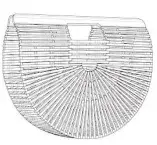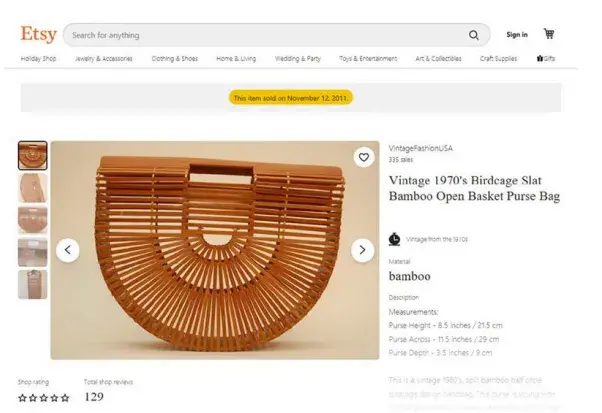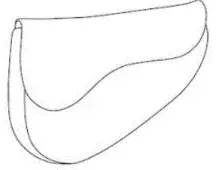By Ananyaa Banerjee and Titiksha Sinha
Cult Gaia is a lifestyle brand founded by Jasmin Larian (hereinafter referred to as “Applicant”) in 2011, which creates beautiful heirloom pieces including bags. Recently, on January 19, 2022, one of its Trade Mark Application No. 87522459 for a three-dimensional bag design  (also called the “Ark Bag”) in Class 18 filed on July 10, 2017 with a user claim of January 27, 2013 was refused registration by the US Patent and Trade Mark Office’s Trade Mark Trial and Appeal Board, on the grounds that the product design is “generic”, and even assuming otherwise, has not acquired distinctiveness.
(also called the “Ark Bag”) in Class 18 filed on July 10, 2017 with a user claim of January 27, 2013 was refused registration by the US Patent and Trade Mark Office’s Trade Mark Trial and Appeal Board, on the grounds that the product design is “generic”, and even assuming otherwise, has not acquired distinctiveness.
The case deals with the complexities that come with seeking registration for product designs, due to the existing bar against functionality, and also the requirement of acquired distinctiveness. Before diving into the issues and the decision of the Board, it is important to understand the existing trade mark registration law on product designs-
Generic Product Design
Under the U.S. Trade mark Act, a generic trade mark cannot be registered. This particular caution is even more stringently followed when it comes to product designs, because while a trade mark can only create a monopoly in a word, a product design (or in other words., a trade dress) would create monopoly in the goods. Therefore, a design which is so common in the industry that it cannot identify a particular source, cannot be granted registration. In order to identify if a product design is ‘common’, it is assessed whether the consumers will associate the product design/trade dress with the genus (i.e., goods/service) or the producer (i.e., Applicant).
Acquired Distinctiveness
If a product design is generic in nature, it may still be granted registration if it has acquired distinctiveness on account of substantive, exclusive and continuous use in commerce. The Applicant has to show that the primary significance of the product design in consumers’ minds is not with respect to the product but the source of the product. The factors that are taken into consideration are association with a particular source by actual purchaser, use (length, degree and exclusivity), amount and manner of advertising, amount of sales, intentional copying and unsolicited media coverage.
Issues and the Decision
1. Generic Refusal– The Applicant’s proposed mark was held to be ‘generic’ in nature, due to a number of reasons, as given below:
A. Identical or nearly identical bags sold on third-party platforms, listed and/or featured on websites/blogs/articles etc., even prior to the Applicant’s use i.e., January 2013. One such listing is given below for reference.

The Applicant tried to discredit this evidence asserting that the third-party websites were selling counterfeits. However, the Board held that the argument does not dismiss the persuasive value of the evidence, as the products listed are prior to the Applicant’s user claim.
B. Applicant’s own acknowledgment that the proposed mark is a copy of a common Japanese bag design- For example, Archived excerpt from Applicant’s own website dated September 23, 2015 describe the Ark Bag as a reproduction of a classic Japanese picnic bag, or a photocopy of an informational card included with the Applicant’s goods which states the Ark Bag as a reproduction of a classic Japanese bag. The Applicant argued that these have no probative value however, the same was overruled by the Board.
C. Evidence of the historical nature of the product design- For example, an excerpt from a book published in 2011, showcased the bag design to be dating back to 1974. The Applicant argued that novelty is not a requirement for protection. However, the Board held that while novelty is not a requirement, it is required that the proposed mark function as an indicator of source, which the Applicant failed to establish.
D. Common knowledge about the product design, by people having substantial experience in the fashion industry and also by consumers, even prior to the Applicant’s use- The people confirmed that the design originates from multiple sources. The Applicant contended that competent evidence does not include random third party comments however, this contention was held to be unpersuasive by the Board. Moreover, the same was held to be inconsistent with the Applicant’s arguments in support of its claim of acquired distinctiveness. Since the Applicant relied on anonymous consumer comments to support its acquired distinctiveness claim (discussed later in this article), the Board held that it is only fair to rely on the comments made in support of the genericness of the mark.
E. Identical or nearly identical bags offered for sale after Applicant’s launch date i.e., January 2013, but prior to it gaining popularity i.e., in 2017- Applicant argued that such use is infringing in nature and that it had sent cease and desist letters however, the testimony of the witness produced by the Applicant was held not convincing by the Board.
2. Lack of Acquired Distinctiveness
A. Association with a Particular Source by Actual Purchasers– Applicant failed to produce any consumer survey or declarations.
B. Length, Degree and Exclusivity of Use– The Board held that even though the proposed mark has been in use since January 27, 2013, the use is not necessarily conclusive and/or persuasive of the acquired distinctiveness. Since there are several identical product designs sold by multiple parties, it defies Applicant’s claim of exclusivity.
C. Amount and Manner of Advertising– The Board held that while the proposed mark has been extensively advertised on social media etc., there is no “look for” advertising in the record that calls a consumer’s attention to the product design. A very important point to note is that consumers tag ‘CULT GAIA’ and associate it with the product design. It is important to understand that the consumers associate the word ‘CULT GAIA’ with the proposed mark however, may not identify the Applicant as a source indicator solely based on a photo of the Ark Bag.
D. Amount of Sales and Numbers of Customers– While the Applicant did provide relevant sales information, the Board held that the Applicant’s level of success without additional evidence as to market share etc., cannot be determined. The Board also highlighted that commercial success of the product does not necessarily indicate that the product design is recognized as a source-indicator.
E. Intentional Copying– Applicant argued that multiple third parties tried to intentionally create unauthorized copies of Ark Bag, and that action was taken against the. However, the testimony lacked specificity as to the scope and the number of actions taken. Moreover, no evidence was provided in support thereof. Therefore, the Board could not determine if the infringers settled and/or cooperated due to the alleged acquired distinctiveness of the proposed mark or to simply avoid litigation.
F. Unsolicited Media Coverage– The Board held that even though the Applicant’s Ark Bag received favourable press, it is insufficient to overcome the evidence in connection with other factors, as stated above.
Conclusion
The Applicant had argued that minor differences exist between the proposed mark and other third-party product designs. However, the Board held that minor differences do not change the overall commercial impression, taking precedence from the Stuart Spector case , wherein it was held that “it is simply not reasonable to conclude that the average consumer of guitars, which would include non-musical parents buying a guitar for their child, could distinguish one guitar from another based solely on a millimetre of difference in the body shape.”. Recently, Dior’s iconic Saddle Bag
and other third-party product designs. However, the Board held that minor differences do not change the overall commercial impression, taking precedence from the Stuart Spector case , wherein it was held that “it is simply not reasonable to conclude that the average consumer of guitars, which would include non-musical parents buying a guitar for their child, could distinguish one guitar from another based solely on a millimetre of difference in the body shape.”. Recently, Dior’s iconic Saddle Bag also could not be granted trade mark registration and was refused by the USPTO citing the same reasons of being generic. As per the USPTO, the “The Saddle Bag design cannot be registered as a trade mark without Dior showing that the design has acquired distinctiveness, i.e. that due to Dior’s extensive use and promotion of the Saddle Bag, consumers now directly associate [the design] with Dior”. After this, Dior filed for an express abandonment to end the challenging pursuit.
also could not be granted trade mark registration and was refused by the USPTO citing the same reasons of being generic. As per the USPTO, the “The Saddle Bag design cannot be registered as a trade mark without Dior showing that the design has acquired distinctiveness, i.e. that due to Dior’s extensive use and promotion of the Saddle Bag, consumers now directly associate [the design] with Dior”. After this, Dior filed for an express abandonment to end the challenging pursuit.
194 USPQ2d at 1567-68
Related Posts
French Luxury Jewelry Brand ‘Cartier’ files lawsuit against Tiffany & Co.
COUNTERFEITING OF LUXURY GOODS- GUCCIO GUCCI S.P.A V/S INTIYAZ SHEIKH


